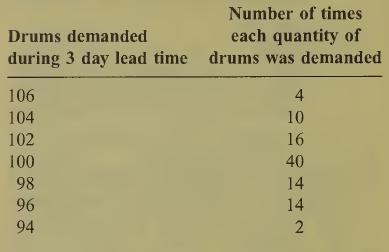Advanced: Safety stocks, uncertain demand and quantity discounts Kattalist Ltd is a distributor of an industrial chemi
Question:
Advanced: Safety stocks, uncertain demand and quantity discounts Kattalist Ltd is a distributor of an industrial chemi¬ cal in the north east of England. The chemical is supplied in drums which have to be stored at a controlled temperature.
The company’s objective is to maximize profits, and it commenced business on 1 October.
The managing director’s view:
The company’s managing director wishes to improve stock holding policy by applying the economic order quantity model. Each drum of the chemical costs £50 from a supplier and sells for £60. Annual demand is estimated to be for 10 000 drums, which the managing director assumes to be evenly distributed over 300 working days. The cost of delivery is estimated at £25 per order and the annual variable holding cost per drum at £45 plus 10% of purchase cost. Using these data the man¬ aging director calculates the economic order quan¬ tity and proposes that this should be the basis for purchasing decisions of the industrial chemical in future periods.
The purchasing manager’s view:
Written into the contract of the company’s pur¬ chasing manager is a clause that he will receive a bonus (rounded to the nearest £1) of 10% of the amount by which total annual inventory holding and order costs before such remuneration are below £10000. Using the same assumptions as the man¬ aging director, the purchasing manager points out that in making his calculations the managing director has not only ignored her bonus but also the fact that suppliers offer quantity discounts on purchase orders. In fact, if the order size is 200 drums or above, the price per drum for an entire consignment is only £49.90, compared to £50 when an order is between 100 and 199 drums; and £50.10 when an order is between 50 and 99 drums.
The finance director’s view.
The company’s finance director accepts the need to consider quantity discounts and pay a bonus, but he also feels the managing director’s approach is too simplistic. He points out that there is a lead time for an order of 3 days and that demand has not been entirely even over the past year. Moreover, if the company has no drums in stock, it will lose specific orders as potential customers will go to rival competitors in the region to meet their immediate needs.
To support his argument the finance director summarizes the evidence from salesmen’s records over the past year, which show the number of drums demanded during the lead times were as follows:
In the circumstances, the managing director de¬ cides he should seek further advice on what course of action he should take.
Requirements:
(a) Calculate the economic order quantity as originally determined by the company’s man¬ aging director. (1 mark)
(b) Calculate the optimum economic order quan¬
tity, applying the managing director’s assump¬ tions and after allowing for the purchasing manager’s bonus and for supplier quantity discounts, but without using an expected value approach. (3 marks)
(c) Adopting the financial director’s assumptions and an expected value approach, and assum¬ ing that it is a condition of the supplier’s contract that the order quantity is to be constant for all orders in the year, determine the expected level of safety (i.e. buffer) stock the company should maintain. For this purpose, use the-figures for the economic order quantity you have derived in answering (b). Show all workings and state any assump¬ tions you make. (5 marks)
(d) As an outside consultant, write a report to the managing director on the company’s stock ordering and stock holding policies, referring where necessary to your answers to (a)-(c). The report should inter alia refer to other factors he should consider when taking his final decisions on stock ordering and stock holding policies.
Step by Step Answer:






